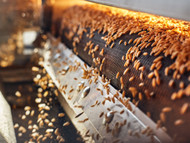What To Know About the Grain Sorting Process
Published by The Grain Handling Direct Team on Nov 1st 2022
Farmers have been harvesting and sorting grain for thousands of years, and while the technology has changed, the process has basically remained the same. If you’d like to learn more about this, you’ve come to the right place. We explain what you need to know about the grain sorting process below.
Threshing
Threshing is the first step after harvesting, in which farmers sort their grain. It involves separating the edible grain from its stalk and the chaff.
We’ve all heard the expression of separating the wheat from the chaff—this is how it happens! In the old days of farming, people would thresh by beating the grain with a flail until the grain loosened. Now, we have combine harvesters for the job.
Winnowing
After threshing, the grain must undergo winnowing. This fully removes the loosened grain from the stalk and chaff so that it’s ready for storage or sale.
Again, farmers used to have to do this process by hand. Before machines, farmers would winnow by simply tossing the grain in the air and allowing the wind to blow the chaff off. The remaining grain would fall back to the ground, where it would be collected. It wasn’t the most complex job in the world, but it was certainly time consuming!
Modern Threshing and Winnowing
We discussed how grain was threshed and winnowed in the old days because combine harvesters do the work of winnowing and threshing all at once today. As a combine goes through the fields and harvests the grain, it cuts the stalks and scoops the wheat into a machine that then threshes the stalks and husks.
Afterward, the grain goes into cylinders called rasp bars, which guide it through grates and sieves to winnow and sort it. Instead of taking time to do all three steps, a combine harvester harvests, threshes, and winnows grain at once in seconds.
Transporting and Storing the Sorted Grain
After harvesting and sorting the grain, it’s time to transport it somewhere else—either to the on-farm storage area or a truck to a grain elevator. Whether going to a grain bin or elevator, the grain takes a trip on grain conveyor systems.
These conveyor systems quickly and securely load the grain into the grain bins and grain elevator facility without destroying it. Afterward, the farmer can store the grain for months or immediately sell it at their discretion.
Now you know a little more about the grain sorting process, from harvesting to threshing and transport. If you need high-quality grain storage and sorting equipment for your farm, Grain Handling Direct has all the necessary tools and equipment!

